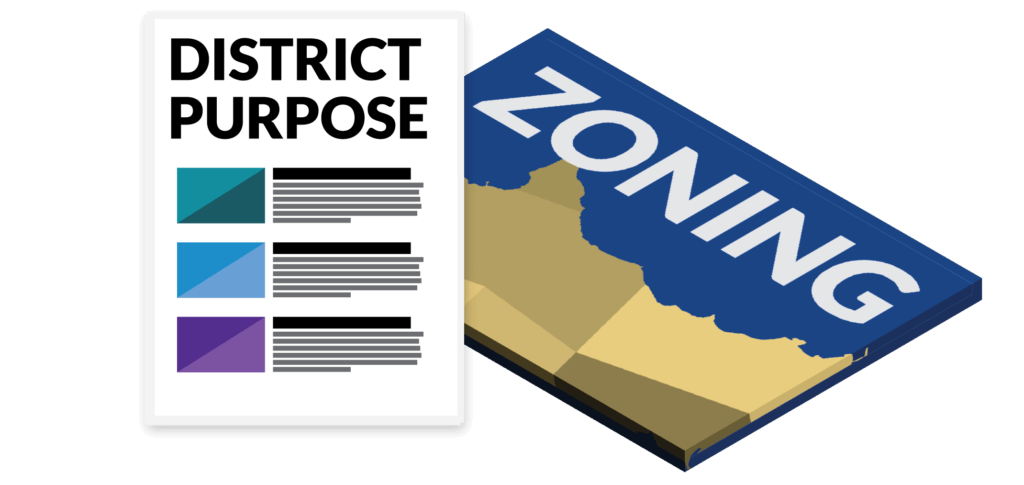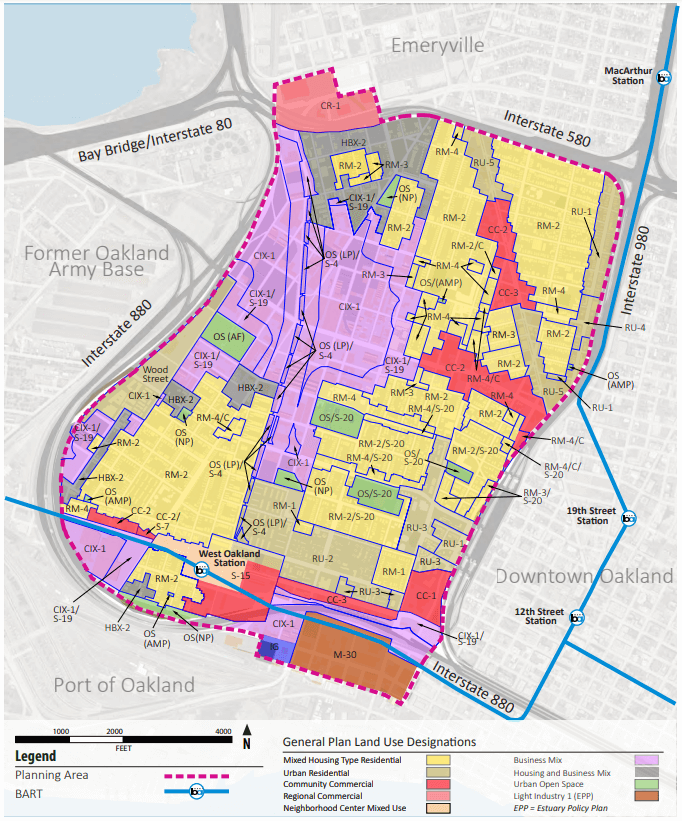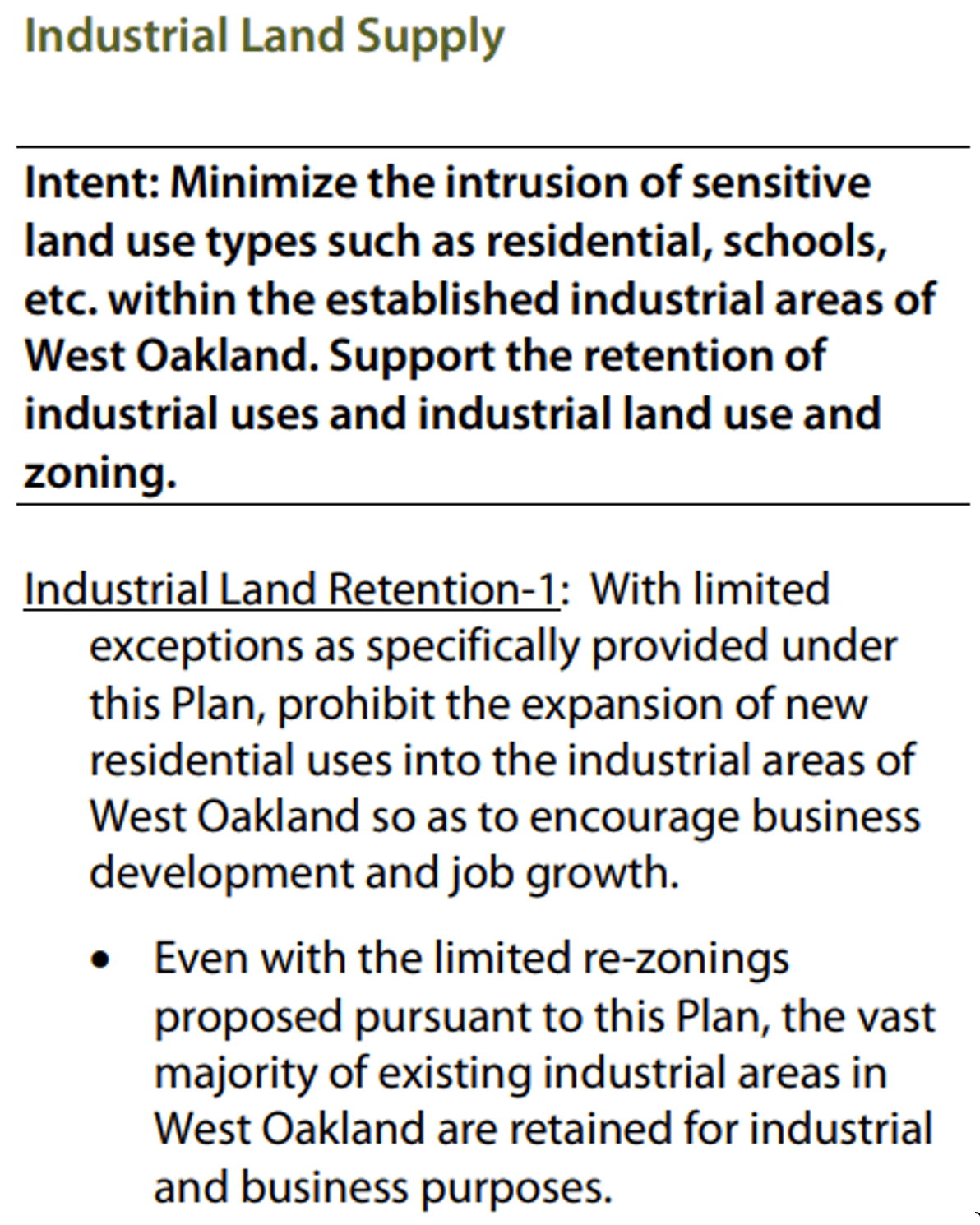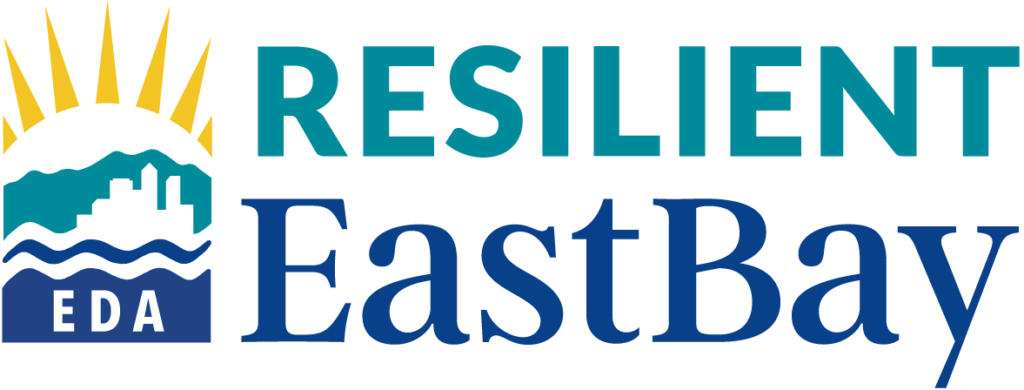Zoning Tools

- Tool 1: Increase Zoning Ordinance Legibility and Clarity
- Tool 2: Update industrial zoning districts and use definitions
- Tool 3: Expand By-Right Development Opportunities Through Use Regulations
- Tool 4: Limit specific use standards
- Tool 5: Increase design review flexibility
- Tool 6: Restrict the rezoning or reuse of industrial land for non-industrial uses
- Tool 7: Expand industrial land supply through rezoning
TOOL 1
Increase Zoning Ordinance Legibility and Clarity
Zoning codes that lack clear and legible language can confuse developers and potential project applicants alike. Jurisdictions should prioritize reviewing code sections that have not been updated in the last decade.
- Zoning ordinances are typically organized by zoning districts, use definitions, use standards, and permitted use lists. This review process can be incremental and focus on only one section of an ordinance’s industrial land related content or comprehensive in evaluating all aspects of the code that address industrial zones.
- Increasing zoning ordinance legibility and clarity should be done utilizing stakeholder engagement to clarify which sections of the code are confusing for users as well as city staff and policy makers.
- After appropriate code changes required to enhance the code’s legibility are identified, cities can revise (or hire a consultant to revise) the appropriate sections of the code either in small pieces or bigger components as resources allow. These recommended changes to zoning will be reviewed by and require City Council approval.
Jurisdictions should prioritize reviewing code sections that have not been updated in the last decade. While there is no single formula for increasing zoning ordinance legibility, the following points identify the key issues that should be considered.
- Zoning ordinances utilize a wide variety of formats and visual presentations – with widely varying amounts of text and graphics. When reviewing, pay careful attention to code legibility challenges for non-native English speakers, such as overly technical or confusing definitions.
- Note the proportion of code that is solely text without corresponding tables/charts/figures and add in any tables/charts/figures that increase ease of understanding for potential developers or applicants.
- Ensure that the zoning code is annotated using an online municipal code application and has easily clickable reference links to other sections of the code.
This tool works best in conjunction with input from staff who do zoning application reviews and have experience with common challenges that applicants face in completing zoning applications and may have a clear understanding of where applicants face challenges with using the zoning ordinance.
Case Study #1 – Colorado Zoning Audit Report
A presentation for the Rocky Mountain Land Use Institute illustrated the benefits of performing a “zoning audit”. More specifically, this presentation outlines the way City Staff may review their zoning code, utilizing a public engagement process to target inconsistencies and confusion surrounding code language.
What to Look At
- Page 9 lists the different types of engagement techniques utilized in Lakewood, CA’s zoning audit.
- Page 28 lists common issues found within local zoning codes regarding legibility and clarity.
– – – – – – – – – – – – – – – – – –
Case Study #2 – City of San Francisco Project Review Meetings
The City of San Francisco Planning Department has a process for applicants to seek a project review meeting with City Staff. This meeting can be used to discuss code and application requirements relating to a proposed project, increasing clarity for developers and limiting time spent by City Staff clarifying or noting missing application materials later on in the approval process.
What to Look At
- The project review meeting application outlines what interested parties must submit and how they will schedule a project review meeting with City Staff.
TOOL 2
Update industrial zoning districts and use definitions
Updating and adjusting a city’s industrial zoning districts and industrial use definitions is an essential way to ensure the code reflects modern industrial business types and flexible buildings that can accommodate multiple potential uses.
Zoning Districts
- Zoning districts both define the overall land use intent for the area within the district and specify which uses are permitted in the area. Each zoning district has a specific set of building standards and permitted uses.
- In addition, the various zoning districts establish the ways in which various land uses interact, and coexist, or are separated from each other.
Zoning Use Definitions
- Use definitions identify individual land uses that may fall under different broad use categories.
- This tool provides guidance as to how to update land use definitions within a zoning classification. This may involve increasing the number of defined uses outlined in the zoning ordinance to ensure that new and/or evolving industrial uses are clearly defined in the code as well as to clarify vague or ambiguous use definitions that can make zoning codes difficult to interpret.
Zoning Districts
- The primary objective for updating zoning districts should be to have fewer industrial zoning districts with a wider array of permitted uses.
- For example, a streamlined zoning code could have only three industrial districts: one light industrial district, one general industrial district, and one mixed-use industrial/commercial district. However, there could be an extensive list of permitted, restricted, or unallowable uses in each district.
Zoning Use Definitions
- The primary objective for updating use definitions should be to update any use definitions that are no longer in line with current industrial use or may be unnecessarily vague.
- For example, ensure that there is a clear description of truckyards versus EV truck charging depots; or not using an overly general term like “research and development” as a use.
- For use definitions, the various types of manufacturing should be defined and permitted on an individual basis – i.e., apparel, beverage, metal, and food manufacturing should all be defined separately in a use list.
Changing both zoning districts and use definitions should be done by the following steps:
- Meet with planners and any economic development staff to identify challenges with existing zoning district and use definitions in the city’s existing zoning code sections pertaining to industrial uses.
- Talk to developers, brokers, and businesses to hear what challenges they see in the existing industrial district and use definitions and how these stakeholders would suggest addressing existing challenges.
- Brief Planning Commission and City Council on initial findings from this input from both internal and external zoning code users.
- Rewrite (or hire consultant to rewrite) appropriate district and use definitions either in small pieces or bigger components as resources allow.
- Recommend changes to the zoning code for Planning Commission and City Council approval.
Of note, updating industrial zoning districts and definitions is best done in conjunction with Tool 1 (increasing zoning code clarity).
Case Study #1 – Fremont, CA
Fremont’s zoning code contains an extensive and in-depth list of defined uses.
This improves applicants’ ability to understand which uses are permitted in which industrial zone and allows for the City to finely specify which uses require discretionary review. Thus, limiting the number of uses that may undergo unnecessary discretionary review. In addition, Fremont has three clearly delineated industrial zones that each serve a specific purpose for the industrial uses in the City. One that allows for a wider range of non-industrial use, one that focuses on tech-related industrial use, and one that serves a wide array of traditional industrial uses.

What to Look At
- Section 18.50.090 of the Fremont zoning code lists permitted uses in each of the three industrial districts.
- Section 18.50.010 shows the purpose and definition of each of the three industrial districts.
– – – – – – – – – – – – – – – – – –
Case Study #2 – Pittsburg and Hayward, CA
The cities of Pittsburg and Hayward, CA both have three clearly delineated industrial districts. One district that permits a wider mix of commercial and industrial uses, one that focuses on lighter and “clean” industry, and one that allows nearly all industrial uses.
What to Look At
- Section 18.54.005 of the Pittsburg zoning code outlines the three industrial districts.
View Pittsburg, CA Zoning Code >
- Section 10-1.1600 of the Hayward zoning code outlines the three industrial districts.
View Hayward, CA Zoning Code >
TOOL 3
Expand By-Right Development Opportunities Through Use Regulations
Conditionally permitted land uses create an extensive discretionary review that can slow the approval process and create increased costs and greater potential risk for developers. Expanding the number of uses that are allowed by-right within any given use district allows for faster project approvals and more development opportunities by decreasing the administrative burden for developers and city staff alike.
Making a clear distinction between by-right uses, uses requiring discretionary review, and prohibited uses within a zoning district is vital, as is making as many uses permissible by right as possible. Increasing by-right uses can be done by establishing more but narrower specific use definitions. This enables the code to separate uses that might have otherwise been included in one use definition. In a zoning ordinance with too few use definitions, uses that should be subject to discretionary review can be lumped together with uses that should not require discretionary review, subjecting every use to greater review than may be necessary.
For example, instead of requiring that a life science building go through an entire approval process due to all life science buildings being listed as a conditional use, a life science building can be permitted by right in a zoning district if the project meets certain use standards relating to hazardous materials. This saves time for developers and local planning departments while still ensuring overall life safety standards are met.
- Uses that are permitted by right in a specific district only require an administrative project review to ensure that the project is compliant with all relevant codes and standards. Whereas uses that are prohibited are not allowed within that district under any circumstances.
- The intent of this tool is to narrow down the number of uses deemed as ‘conditional’, ‘temporary’, or ‘accessory’ which are likely to require additional review by a zoning administrator, planning commission, or city council. To change which uses are permitted by-right in specific districts, a city must enact amendments to the appropriate sections of their zoning code – which requires review and approval from the local planning commission and city council.
Expanding by-right development potential can be done by meeting the objectives below:
- Review existing permitted use lists to identify uses that could be permitted by-right but currently require some form of discretionary review. The main objective of this review is to limit the required discretionary review process to industrial uses that have the potential for severe public nuisance or hazard.
- Remove uses from requiring a Conditional Use Permit (CUP), or a similar discretionary permitting process, if these uses do not have the potential for sever public nuisance or hazard. Amend the appropriate zoning districts to make these uses permitted by right.
- Encourage the use of Administrative Use Permits (AUP) or Zoning Administrator Permits (ZAP) instead of CUP’s when some review is necessary but where a full hearing process may not be required. AUP’s and ZAP’s allow for discretionary review of development proposals without full committee or board approval. Reducing the approval process burden benefits local planning departments and developers/project applicants.
Of note, expanding by-right development potential is best done in conjunction with Tools 2 (update use definitions) and 4 (limit specific use standards).
Case Study #1 – Fremont, CA
Fremont has a very limited number of uses that require a CUP, allowing for a wider range of uses to be permitted by-right. Instead, the City utilizes the ZAP process to govern certain uses that may require a reduced level of discretionary review.
What to Look At
- Table 18.50.090 within Fremont’s zoning code contains the full list of permitted uses in each industrial district. Most uses are either outright permitted or prohibited depending on the industrial zone.
- Section 18.50.090 contains definitions of conditional use permits and zoning administrator permits.
– – – – – – – – – – – – – – – – – –
Case Study #2 – West Berkeley Area Plan
The West Berkeley Area Plan, and the City of Berkeley Zoning Code, largely list uses as permitted or non-permitted, or requiring an AUP; meaning that there are very few uses that require extensive discretionary review.
What to Look At
- The 2011 amendment to the West Berkeley Area Plan removed the requirement that any use automatically require a public hearing within each of the city’s manufacturing/industrial districts. Meaning that uses only need discretionary review if that specific use requires a use permit from the City of Berkeley.
TOOL 4
Limit specific use standards
Specific use standards can add ambiguity to a zoning code and cause confusion for potential developers/project applicants. Specific use standards should be applied primarily to uses that have the potential to create a public nuisance or hazard.
Specific use standards are an additional layer of performance standards that a given use must meet in addition to any relevant zoning district and general performance standards.
- For example, a zoning code may have specific use standards for warehousing uses that specify additional screening and storage requirements that must be met in addition to any general screening and storage standards required of all uses.
- Review all specific use standards listed in the zoning code and determine if there are additional sets of standards for uses that have very limited or no significant potential for public nuisance or hazard.
- Specific use standards for these uses could be removed from the zoning code.
- If multiple uses within a use district have the same specific use standards pertaining to hazardous waste storage or use, it may be preferable for the zoning code to contain a general hazardous waste specific use standard that can be applied to all uses with hazardous waste potential.
- Remove any outdated specific use standards that are no longer relevant to a specific use.
- If there are multiple uses that have similar specific use standards, consider the possibility of adding these standards to the general performance standards for an industrial zoning district.
Changing or removing specific use standards requires an amendment to the zoning code and approval from both the planning commission and city council.
Of note, limiting specific use standards is best done in conjunction with Tool 3 (increasing by-right development potential).
Case Study #1 – San Leandro, CA
San Leandro’s Zoning Code has a limited number of specific use standards. Of note, the code contains specific use standards for hazardous waste storage and walls adjoining residential use, both of which may be relevant to prospective industrial uses.

What to Look At
- Chapter 4.04 Article 1 outlines specific use standards for non-residential districts.
- Section 2.12.228 contains additional use restrictions for all industrial districts.
– – – – – – – – – – – – – – – – – –
Case Study #2 – Concord, CA
Concord’s Zoning Code lists all standards for specific uses in one section, increasing legibility and clarity on which uses have additional standards. This zoning code contains very few specific use standards relating to industrial use.
What to Look At
- Table 18.50.020 contains any specific use standards that a use must meet.
- Chapter 18.200 lists all standards for specific uses, regardless of zoning district.
TOOL 5
Increase design review flexibility
A zoning ordinance with extensive and detailed design review guidelines can limit the potential for changes in industrial land uses and small-scale industrial development by adding cost and administrative burden for both local government and developers.
- Development projects or changes of uses must typically undergo discretionary design review and meet specific design standards.
- These design standards may relate to a variety of items such as the building design and shape, exterior building materials, landscaping, and circulation.
- Design review is a necessary aspect of the entitlement process, but flexibility can be added to the process by exempting certain smaller scale development and use changes from design review.
- Review design review guidelines and check that all standards are necessary and clear.
- For example, confirm that exterior building material guidelines are easily understood and do not contain an extensive, and difficult to read, tiered systems of building material allowances.
- Revise or remove any design standards that are not relevant for industrial uses. This may require creating a specific industrial design review section within the zoning code, instead of utilizing general design review standards for all uses.
- Create an exemption for certain industrial uses to alleviate the administrative burden for both local government and developers/project applicants.
- For example, industrial building additions or improvements of less than 1,000 square feet that do not abut residentially zoned property would be exempt from full design board review.
Case Study #1 – Oakley, CA
Oakley’s Zoning Code has a specific section of code outlining industrial design review, which increases clarity for industrial developers as to which design standards must be adhere to. In addition, Oakley grants the Zoning Administrator power to review and approve an addition to a main industrial building.
What to Look At
- Section 9.1.1604 (d) contains specific design review guidelines for industrial districts. This includes permitting the Zoning Administrator to approve an application for design review if the development is an addition to a main building where the gross floor area of the addition is less than 10,000 square feet or 25% of the existing floor area of the main building, whichever is less.
– – – – – – – – – – – – – – – – – –
Case Study #2 – Richmond, CA
Richmond’s Zoning Code has design review exemption for smaller industrial development, decreasing the administrative burden on small scale development and industrial expansion.
What to Look At
- Section 15.04.930.020 (C) lists the exceptions to full Design Review Board review. Specifically, any industrial additions or improvements of less than 1,000 square feet are exempt.
TOOL 6
Restrict the rezoning or reuse of industrial land for non-industrial uses
Many cities lack language in their zoning ordinance that explicitly protects industrial land from being rezoned to allow non-industrial land use. The loss of industrially zoned land can have multiple negative consequences for cities including removing opportunities for many local serving businesses such as construction firms or auto repair shops to operate, eliminating inexpensive and highly flexible space that can incubate many kinds of innovative enterprises, or by allowing higher value real estate development including housing or office buildings to be built next to industrial uses, increasing real estate values for the industrial land and incentivizing property owners to sell their property to be redeveloped for higher and better use.
- Typically, a zoning ordinance will limit either the rezoning or reuse of industrial land, but not both. Restricting the rezoning of industrial land is a significant way to ensure that industrial development and uses can continue to operate in a specific portion of a city well into the future.
- Rezoning or reuse restriction is typically addressed in the zoning code under the section that outlines the purpose of a code’s industrial districts. This section typically lays out a list of standards that a prospective use must meet to be approved for rezoning or reuse.
- Any type of industrial land protection should consider future land use patterns laid out in a City’s Land Use Element of their General Plan.
If a city is losing large amounts of industrial land, the city would benefit from establishing restrictions on rezoning or reuse of that land.
- Establish a section within the zoning code that restricts the rezoning of industrial land. This section will contain standards that must be met by a prospective use to secure rezoning approval.
- The following objectives should be met when creating industrial rezoning restriction standards:
- Only permit the rezoning of industrial property if industrial uses are no longer compatible with the surrounding area.
- Any applicant for rezoning must demonstrate that the rezoning of industrial land provides a significant benefit to the city.
- Add any standards that relate to city goals identified in the general plan. For example, rezoning of industrial land may be permitted if the site is located near a transit station and therefore rezoning would provide a major opportunity to meet transit-oriented development goals.
- The following objectives should be met when creating industrial rezoning restriction standards:
Adding an industrial land rezoning restriction to the zoning code requires a zoning amendment and approval from planning commissioners and city council.
Case Study #1 – West Berkeley Area Plan and West Oakland Specific Plan
Both the West Berkeley Area Plan and the West Oakland Specific Plan restrict the conversion of industrial uses in some form. The West Berkeley Area Plan limits the conversion of industrial uses in general, and the West Oakland Specific Plan prohibits the expansion of residential uses into industrial areas of West Oakland.

What to Look At
- West Berkeley Area Plan – The area plan limits the change of use of any manufacturing, wholesale trade, or warehouse use to a use other than manufacturing to 25% of the floor area of the building. View West Berkeley Area Plan Case Study >
West Oakland Specific Plan – Section 4-13 of the specific plan outlines the intent to limit the expansion of new residential uses into the industrial areas in West Oakland. View West Oakland Specific Plan >

– – – – – – – – – – – – – – – – – –
Case Study #2 – Fremont, CA
Fremont’s Zoning Code restricts the rezoning of industrial land by laying out standards that must be met by a project in order to secure rezoning approval.
What to Look At
- Section 18.50.020 contains the conditions that must be met by a potential development for the rezoning of industrial land in Fremont.
TOOL 7
Expand industrial land supply through rezoning
Cities with a limited industrially zoned land supply could consider increasing their industrial land supply by allowing industrial uses in areas formerly occupied by retail and/or office uses. As industrial processes have evolved over time, many uses that fall under the industrial umbrella can be accommodated in existing commercial and mixed-use buildings without creating land use compatibility issues for other adjacent commercial activities. For example, many types of life science use are starting to reuse former office space in certain areas.
A city can expand their industrial land supply through a variety of rezoning methods, such as:
- Broadening the number of industrial uses permitted in mixed-use or commercial zones.
- This approach works like Tool 3 (Expand By-Right Development Opportunities), but instead of focusing on broadening existing permitted uses in industrial zones the focus is to increase the number of industrial uses permitted in non-industrial zones.
- Allowing planned use development (PUD) that permits a wide range of potential tenants and uses in areas previously zoned for only commercial and/or retail uses.
- PUDs are a useful way for developers to target land for industrial tenants without knowing in advance what specific uses may come to that land in the future.
- Typically, PUDs are established to achieve a general goal, such as creating an industrial office park, and there is no set list of permitted uses for the district. Therefore, any potential use may be permitted if it adheres to the PUDs general purpose.
- It is important to note that PUDs create a relatively high level of administrative burden and should not be over-utilized. Though, targeted use of PUDs can provide enormous industrial development potential and flexibility for a city.
- Utilizing industrial overlay districts that designate land for future industrial growth potential.
- Establishing overlay districts can provide a variety of benefits, such as setting a primary land us focus in an area. One way that overlay districts can be utilized to expand industrial land supply is by identifying land set aside for future industrial use.
- An industrial overlay that identifies land for future industrial use may restrict future development that does not meet the purpose and goals defined by the overlay district. For example, an overlay district may be established for a future industrial area that will focus on advanced manufacturing and deep tech.
These methods vary in their administrative burden and flexibility, but all provide cities with additional ways to permit a wide variety of industrial uses. In addition, all methods require full planning commission and city council approval.
To identify which method(s) would allow a city to expand industrial land supply most efficiently, a variety of factors should be determined.
- Is there vacant or underutilized property in the city that would be appropriate for industrial use.
- If so, then rezone this property to an appropriate industrial district.
- Or establish an overlay zone that restricts non-industrial development on this land, protecting it for future industrial use.
- Does a city’s existing mixed-use or commercial zones permit “light industry” in some capacity.
- If not, then the zoning could be amended to broaden the number of industrial uses permitted in these zones.
- If a city utilizes PUDs, ensure that permitted uses for PUDs are flexible.
- For example, instead of utilizing a specific list of permitted uses, a city may permit any future use in a PUD district if it adheres to the goal of the PUD.
Of note, expanding industrial land by zoning is best done in conjunction with Tools 3 (encourage by-right development) and 2 (update industrial zoning districts and use definitions).
Case Study #1 – Vacaville, CA (Northeast Growth Area Overlay)
Vacaville’s Zoning Code contains the Northeast Growth Area Overlay, a district intended to retain land for job generating uses such as high-quality offices, industrial uses, and technology campuses.
What to Look At
- Goal LU-18 within Vacaville’s Land Use Element lists policies that surround the intended growth for the Northeast Growth Area. This includes a limit on subdivision and residential uses in the area to preserve land for large-parcel technology campus use.
- Chapter 14.09.191 of the Zoning Code illustrates the purpose and regulations surrounding the Northeast Growth Area Overlay District. The overlay permits uses that would not restrict land for future intended industrial development, such as agricultural uses and animal production facilities.
– – – – – – – – – – – – – – – – – –
Case Study #2 – Pleasanton, CA
Pleasanton’s Zoning Code contains a Planned Unit Development District (PUD) with flexible use permission. This flexibility has permitted the development of large PUD’s within the City that have a variety of different types of industrial uses.
What to Look At
- Chapter 18.68 contains the standards and purpose of Pleasanton’s PUD district.
- Section 18.68.030 outlines the permitted uses within a PUD district. Specifically, it gives full authority to the planning commission and city council to permit any use in the PUD district.




